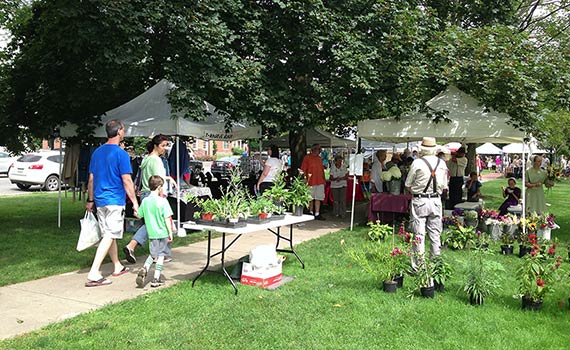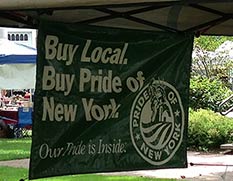
Article submitted by Kathryn Bacher’14
As an eight-year-old, calling me either a picky or unhealthy eater were both extreme understatements. Breakfast consisted of some sugary cereal like Fruit Pebbles or Cinnamon Toast Crunch that undoubtedly turned my milk a different color. Lunch was always a turkey sandwich on white bread, nothing else inside. Afterschool snacks were Gushers, Fruit Roll Ups, and Oreos. Dinner was frozen fish sticks heated up and dunked in ketchup. If my dad was taking me out to eat, we went to McDonalds so I could add another Happy Meal toy to the collection kept in my desk drawer. When my family went somewhere fancier, my decision was almost always between chicken fingers and fries or plain pasta with butter. My mother tried relentlessly to sneak a piece of lettuce into my turkey sandwich or accidentally forget to buy my frozen bag of fish sticks, but my palette accepted few other items other than the ones listed above.
Like most kids, I never considered the cow that was killed for my Happy Meal burger, how my gushers were made, where my turkey was produced, or who made my fish sticks. Over the years my palette thankfully expanded and healthier options were incorporated into my meals, but processed food still made up the majority. Sure there was a nutrition unit in health class every year, but most information was quickly forgotten after the exam. No person or source of information seemed capable of changing my ways.
That is, until a month ago when I made my first purchase from the Hamilton Farmers’ Market. Over the past three years, I visited the market often to meander and try free samples, but never purchased anything. As an underclass student at Colgate, I was dependent on a meal plan and ate whatever was made for me, no questions asked. Now, without a meal plan to rely on, I began paying more attention to the food I was purchasing and cooking for myself. Who would have thought that my unhealthy picky palette could transform into what it is now- I am a weekday vegetarian who eats organic, and have almost completely reduced my intake of processed food.
The market, reminiscent of food production prior to commercialization, brings the community together while establishing rapport between farmers and local residents. Personally, the experience of shopping at the market in itself is just as great as enjoying the fresh food at home. While there is no processed food, there is locally grown produce, herbs, jam, honey, granola, eggs, cheese, grass-fed meat, and arugula picked that very morning. The food is slightly more expensive, but it tastes better and is healthier since it is harvested at the peak of its fresh and nutritional quality. I gladly pay the higher prices knowing that I am giving it to the actual person who briefed me on the food’s production, instead of a tired supermarket cashier who can tell me no more than which aisle the item can be found. To those who struggle with the higher prices of the market, I must quote Birke Baeher, a fourteen-year-old food advocate who states simply, “we can either pay the farmer now or the hospital later”.
Clearly, others share similar positive health and social experiences at their local Farmers’ Markets as evident from the boost in the national count of markets, which increased from 4,685 in 2008 to 7,864 in 2012. This explosion of Farmers’ Markets is the result of and contributes to, the growing local food movement, which builds more locally based, self-reliant food economies. According to Sarah DeWeerdt, the average American food product travels about 1,500 miles between where it is produced and where it is eaten, while any food that travels 50-400 miles is considered local. So many consumers have expressed an interest to eat local food that the word locavore was even added to the Oxford American Dictionary in 2007.
Are there ecological benefits of eatinglocal food? This is a question I have been wrestling with. The answer, it turns out, is not straightforward. On the surface, it seems obvious that long routes require more fuel for transportation. This, in turn, produces more pollution, and often requires the use of additives to preserve and boost the food’s flavor. However, the ecological benefit of shorter food miles has become a target of scrutiny. Critics argue that there are many other parts of the food system to consider with food miles being only a small part of the whole. For example, from the moment a seed is planted, ecological impacts must be considered. According to Hiroko Shimizu, planting, irrigating, harvesting, using heated greenhouses, and applying fertilizers and pesticides contribute far more greenhouse gases (83%) than food miles (4%).After the food is grown, it must be packaged and transported, the type of packaging and the mode of transportation both being important factors to consider. Most importantly, the type of food we eat matters. According to the United Nations, the meat and dairy industry emit more emissions than all the world’s transport combined. Explains the Environmental Working Group, “if everyone in the U.S. ate no meat or cheese just one day a week, it would be like not driving 91 billion miles – or taking 7.6 million cars off the road.” Among developed nations, the U.S. has the highest consumption of meat, up to 208 pounds per person annually, which is 60% more than Europeans consume. Thus, a dietary shift away from meat might be a more effective method to mitigate our environmental impact. Upon examining the entire life cycle of food, there are many other indicators that contribute to the ecological footprint besides transportation distances. Are critics correct and is local production inconsequential in the grand scheme of things?
Personally, I disagree with the critics. The local food movement reduces environmental impacts because production on small, local farms helps to ensure that all other stages, in the production, distribution, and consumption of food are sustainable. Regarding the first phase of production, smaller, local farms have the ability to grow food in a more sustainable manner by employing organic growth methods, low tillage, efficient irrigation, and crop diversification. Similarly, these farmers often ensure livestock are grass-fed and have space to graze, unlike Concentrated Animal Feeding Operations (CAFO) in which animals are crammed into tiny stalls devoid of vegetation. Next, since the food is produced locally, it does not need to be preserved with additives or heavy packaging materials. Finally, the shortened supply chain means that the transportation distance is shorter. Many tend to only associate the shorter food miles with the movement, instead of recognizing that the movement encourages sustainability at every stage along a food’s life from production to plate.
As a student at Colgate University, I would like to see the local food movement become a bigger issue on campus. Colgate is located in Madison County, which has a total of 754 farms, making it an ideal location for the movement to flourish (Lifelong Learning Program: The Changing Face of Madison County Agriculture lecture).Colgate also has a large affect on the economy of Madison County and can be a key player to help keep money in the area. However, Hamilton’s cold seasonal temperatures are not ideal to feed 2,900 students, especially when the growing season and academic calendar are on opposite schedules. Student attitudes present another challenge since their demand for name brand foods influences purchases in the dining halls.
Colgate is doing its part to support the movement; many students do not even realize that about 20% of Colgate’s food is produced locally or is third-party certified (organically or sustainably produced). In addition, Colgate has a community garden that grows food, which is then sold back to the dining halls; students can even volunteer with gardening tasks if they desire. Moreover, there are plenty of local food options in the surrounding community such as the Community Supported Agriculture (CSA) Common Thread vegetable share option for Colgate students, Parry’s indoor Farmers’ Market once a month in the winter, and the Farmers’ Market on the Village Green from early May to November 2nd.
 The first step to creating a local food movement on campus begins with education. No individual will make the concerted effort to buy higher priced food without understanding the reasoning behind it. If I had been educated on the dangers of the globalized food system when I was eight years old, I know that I would have started eating local food a lot sooner than just a few weeks ago. We need to shift our thinking from short-term pleasure to long-term health and environmental benefits. Students should want to know where their food comes from, how it was produced, when, and by whom. I never asked these questions until I was forced to buy and cook for myself, but I want to encourage students on a meal plan or those who have others cook forthem to uncover these answers.
The first step to creating a local food movement on campus begins with education. No individual will make the concerted effort to buy higher priced food without understanding the reasoning behind it. If I had been educated on the dangers of the globalized food system when I was eight years old, I know that I would have started eating local food a lot sooner than just a few weeks ago. We need to shift our thinking from short-term pleasure to long-term health and environmental benefits. Students should want to know where their food comes from, how it was produced, when, and by whom. I never asked these questions until I was forced to buy and cook for myself, but I want to encourage students on a meal plan or those who have others cook forthem to uncover these answers.
So whatever your reason for supporting the local food movement, whether it is your health or the ecological impact, know that the benefits are inextricably linked. As Michael Pollan puts it, “if you’re really concerned about your health, the best decisions for your health turn out to be the best decisions for the farmer and the best decisions for the environment- and that there is no contradiction there”. So start asking those questions that large food corporations try to avoid and recognize that foodis a matter of quality over quantity. Try to eat less meat and junk food, buy local, and vote for a sustainable food system with your wallet.


